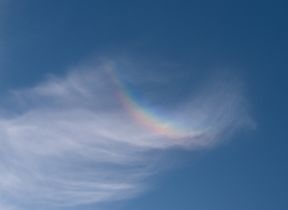Haloes and Coronas
Find out more about Haloes and Coronas and how they form.
Haloes
Haloes require ice crystals to form - either from high cirrus cloud of free falling crystals. Typically sunlight or moonlight is reflected by ice crystals producing a white halo. However, if the light rays strike the light at a particular angle, some light may be refracted. In such situations the halo will have a faint colouration.
The majority of ice crystals are hexagonal, or six-sided, and the most common angle of refraction through such a crystal is about 22 degrees. This is the most frequent type of halo and they are named 22° Haloes. Crystals with a different structure or that are at a different angle to the Sun may result in haloes that vary in size. Small haloes produced at 9° and larger ones at 46° are relatively common, and in some cases only part of a halo forms; appearing like an arc.
In the past haloes and other such atmospheric phenomena were used as an empirical form of weather forecasting before the development of meteorology. There is some degree of truth in this. The high cirrus cloud which contains the ice crystals required for haloes to form often signifies an approaching frontal system; however in many cases the front will be inactive or simply change course from the area - producing no rain.
Coronas
It is common for most optical phenomena to arise through a combination of reflection, refraction and diffraction, but coronas form from diffraction alone.
Diffraction is the apparent bending of waves around small objects and spreading out of waves past small openings. Think of a wave bending around a cove at the beach, or waves spreading out as they pass through an opening in a harbour wall.
In terms of the diffraction of light waves, an example is a corona. These are most common around the moon where the diffraction of uniformly sized water droplets causes white light to separate into colour. The smaller the droplet the larger the corona. Although they are visible around the sun, the corona produced is weaker than the bright direct sunlight itself, making it harder to see.
The ideal conditions occur when the moon sits behind newly formed, mid-level clouds such as altostratus. Newly formed clouds have the same sized droplets, but as the cloud develops, the droplets vary causing irregular shaped rings and more diffuse colours in the corona.





